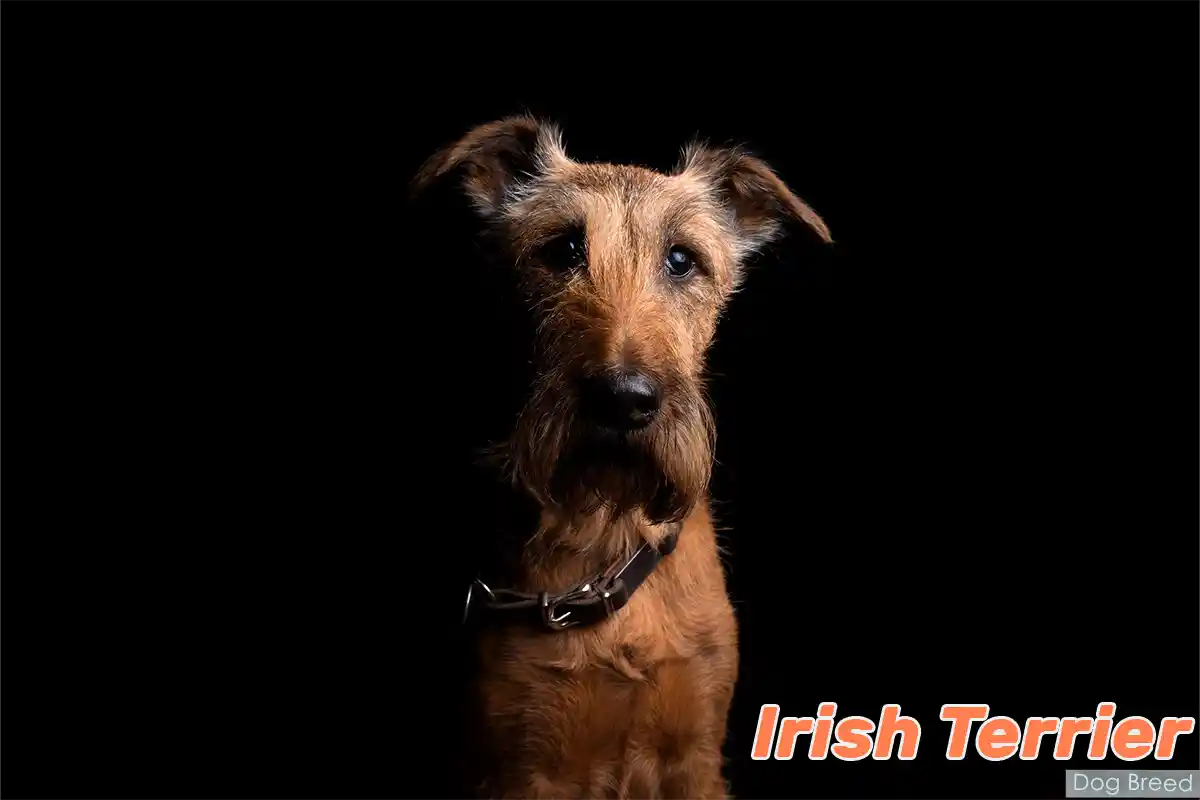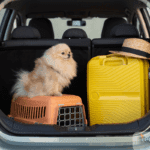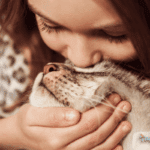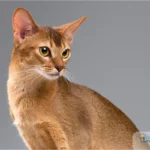Meet the Irish Terrier, a bold and loving breed renowned for its spirited personality, unwavering loyalty, and striking red coat. Dubbed the “Daredevil of the Dog World,” the Irish Terrier is a versatile companion, perfect for active individuals, adventurous families, and experienced dog owners.
With a combination of bravery and a tender heart, Irish Terriers excel as both fearless watchdogs and affectionate family members. Whether patrolling the yard, playing fetch, or curling up by your side, this breed thrives on companionship and purpose.
Their adaptability and keen intelligence make them an exceptional choice for those seeking a trainable, energetic, and devoted dog. But their strong will requires consistent training and an owner who can match their zest for life.
Quick Facts: Irish Terrier
Here’s a snapshot of Irish Terrier traits to help you understand their unique qualities:
| Characteristic | Description | Rating |
|---|---|---|
| Size | Males: 18–20 inches (46–50 cm), 25–27 lbs (11–12 kg); females slightly smaller | ⭐⭐⭐⭐ |
| Average Lifespan | 13–15 years | ⭐⭐⭐⭐ |
| Intelligence Ranking | Highly intelligent and independent | ⭐⭐⭐⭐ |
| Exercise Requirements | High; needs 1–2 hours of vigorous activity daily | ⭐⭐⭐⭐⭐ |
| Grooming Needs | Low; requires regular brushing and occasional hand-stripping | ⭐⭐⭐ |
| Training Adaptability | Trainable but needs firm, consistent guidance | ⭐⭐⭐⭐ |
| Compatibility with Children | Excellent; playful and protective | ⭐⭐⭐⭐⭐ |
| Energy Level | High; thrives on activity and engagement | ⭐⭐⭐⭐⭐ |
| Shedding Level | Minimal; hypoallergenic coat | ⭐⭐⭐⭐ |
| Apartment Living | Possible with sufficient exercise and stimulation | ⭐⭐⭐ |
| Health Issues | Prone to urinary stones and genetic conditions | ⭐⭐⭐ |
| Cost of Ownership | Moderate; includes training, grooming, and health care | ⭐⭐⭐ |
| Vocal Tendency | Moderate; barks to alert | ⭐⭐⭐ |
| Social Needs | High; bonds strongly with family | ⭐⭐⭐⭐⭐ |
- • Fearless and Loyal: Known for their bold nature, Irish Terriers form deep emotional connections with their families. Their unwavering courage and affectionate demeanor make them an outstanding companion.
- • Independent Yet Trainable: While Irish Terriers are intelligent and quick learners, their independent streak requires a patient and consistent training approach.
- • Energetic and Playful: With boundless energy, these dogs thrive on physical activities like running, agility training, and outdoor adventures. Regular exercise is a must to keep them mentally and physically healthy.
- • Great with Kids: Irish Terriers are known for their playful and protective nature, making them a wonderful addition to families with children.
- • Minimal Shedding: Their wiry, hypoallergenic coat sheds minimally, requiring routine brushing and occasional hand-stripping to maintain its texture.
- • Versatile and Adaptable: Whether as a guard dog, a family pet, or an agility champion, the Irish Terrier’s versatility shines through in every role.
Irish Terriers are known for their spirited nature and intelligence. Mastering “Essential Dog Training Commands” an help refine their behavior and showcase their sharp minds.

History and Origins of the Irish Terrier
The Irish Terrier, one of the oldest terrier breeds, carries a rich history that reflects its unwavering loyalty, fearless spirit, and versatile nature. Originating in rural Ireland during the 19th century, these striking dogs were bred to protect farms, hunt vermin, and serve as devoted companions. With their fiery red coats and tenacious personalities, Irish Terriers quickly became symbols of courage and affection.
Quick Facts About Irish Terrier Origins
| Aspect | Detail |
|---|---|
| Geographic Origin | Ireland |
| Purpose | Farm guardian, vermin hunter, and loyal companion |
| First Recognition | Recognized by The Kennel Club (UK) in 1873 |
| Introduction to the U.S. | Early 20th century; beloved by families and working dog enthusiasts alike |
| Notable Contributions | World War I messengers, family guardians, and show champions |
| Breed Development | Likely a mix of native Irish breeds, refined for agility, courage, and companionship |
Irish Terrier Breed Development in Ireland
In the mid-19th century, Lord Dudley Marjoribanks, later known as Lord Tweedmouth, sought to Bred in the lush landscapes of Ireland, Irish Terriers were developed to excel in demanding environments. Farmers needed a versatile dog that could protect their property, hunt pests, and form close bonds with the family. Through careful breeding, essential traits were cultivated:
- Courage and Tenacity: Ideal for confronting threats and guarding livestock.
- Loyalty and Devotion: Strengthened their bond with families.
- Speed and Agility: Enabled swift movements for hunting vermin or chasing game.
Their fiery red coats, a hallmark of the breed, were both a practical choice for visibility and a symbol of their bold character.
From Farms to the Frontlines
Irish Terriers showcased their bravery during World War I, serving as messenger dogs in some of the war’s most dangerous situations. Their intelligence and fearlessness made them invaluable to soldiers, solidifying their reputation as loyal and heroic companions.
A Versatile Breed for Every Role
The Irish Terrier’s adaptability allowed them to transition seamlessly between roles. Whether as protectors on the farm, loyal family pets, or show champions, these dogs have proven their value and charm for generations:
- Show Champions: Their striking appearance and confident demeanor make them favorites in competitions.
- Family Guardians: Known for their gentle yet protective nature with children.
- Working Dogs: Still capable of fulfilling traditional tasks on farms or as service dogs.
Recognition and Global Popularity
Officially recognized by The Kennel Club of the UK in 1873, the Irish Terrier quickly gained international popularity. By the early 20th century, they had made their way to North America, capturing the hearts of families and working dog enthusiasts alike.
Why the Irish Terrier Stands Out
From their humble beginnings in Ireland to their roles as cherished family members, Irish Terriers have remained symbols of loyalty, bravery, and adaptability. Whether guarding homes, competing in dog shows, or forming deep bonds with their owners, they excel in every role they take on.
Before welcoming a Irish Terrier into your home, consider these “10 Essential factors for bringing a new pet home”.
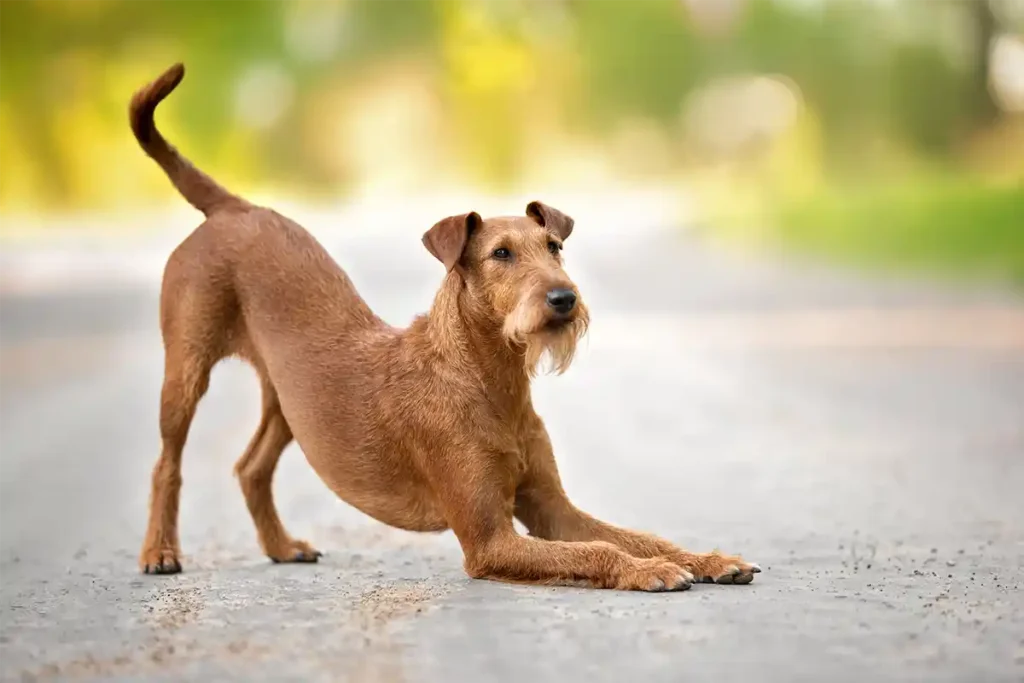
Personality Traits of the Irish Terrier
The Irish Terrier is a bold and spirited breed, beloved for its fearless nature, boundless energy, and deep loyalty. Known as the “Daredevil of the Dog World,” this breed thrives as both a vigilant protector and an affectionate family companion. Their independent streak and energetic demeanor make them a perfect fit for active families or individuals who appreciate a strong-willed yet loving dog.
Table: Irish Terrier Personality Profile
| Trait | Description |
|---|---|
| Independence | Strong-willed but deeply loyal; thrives in homes with confident leadership. |
| Energy Level | High; requires 1–2 hours of vigorous exercise daily. |
| Social Interaction | Bonds strongly with family but may be reserved with strangers. |
| Protectiveness | Naturally protective; acts as a fearless guardian of home and loved ones. |
| Trainability | Intelligent and eager to please but needs consistent, firm training. |
| Compatibility with Kids | Playful and patient; great with children when socialized early. |
| Compatibility with Pets | Sociable but may show dominance without proper introduction and training. |
Loyal and Affectionate Companions
Irish Terriers form unbreakable bonds with their families, earning their reputation as fiercely loyal companions. These dogs thrive when included in family life, relishing opportunities to guard their loved ones or join in on daily adventures. Their affectionate nature shines when they are treated as an integral part of the household.
Real-Life Example: Many owners recount stories of their Irish Terriers’ unwavering devotion, such as staying close to children during outdoor play or alerting their family to unfamiliar sounds around the home.
Energetic and Playful
Brimming with energy, Irish Terriers require daily exercise to stay happy and healthy. Activities like long walks, agility training, or games of fetch are essential for meeting their physical and mental needs. Without sufficient stimulation, these spirited dogs may resort to unwanted behaviors like digging or chewing.
Intelligent but Independent
Irish Terriers are quick learners, making them highly trainable. However, their independent streak can pose challenges, requiring confident leadership and consistent training. Early socialization and positive reinforcement methods, such as treats and praise, are key to unlocking their full potential.
Pro Tip: Keep training sessions brief and engaging to hold their attention. Incorporate tasks that stimulate their problem-solving skills, such as puzzle toys or obstacle courses.
Real-Life Example: Irish Terriers are often praised for their ability to master advanced commands or excel in activities like tracking and retrieving.
Protective and Fearless
As natural guardians, Irish Terriers take their protective role seriously. While they are affectionate with their families, their alert nature ensures they will warn of potential threats. This combination of courage and loyalty makes them exceptional watchdogs.
Key Insight: Early socialization is critical to help balance their protective instincts, ensuring they remain friendly and confident in new situations.
Friendly Yet Selective
Irish Terriers bond deeply with their families but may be reserved with strangers or assertive with other pets. Proper introductions and early socialization are essential to help them adapt to multi-pet households or social settings.
Real-Life Example: Many owners describe their Irish Terriers as loving “peacemakers” within their families, carefully balancing loyalty and playfulness while maintaining their guardian instincts.
Emotionally Attuned
Despite their bold nature, Irish Terriers are deeply in tune with their family’s emotions. These dogs are known for their expressive eyes and ability to provide quiet comfort during stressful times, making them cherished companions for those seeking an emotionally supportive pet.
Fun Fact: Irish Terriers are often seen resting their heads on their owners’ laps during moments of sadness or stress, offering silent but meaningful support.
Why Choose a Irish Terrier?
For active families or individuals seeking a loyal, courageous, and intelligent companion, the Irish Terrier is an outstanding choice. Their spirited personality and affectionate nature ensure they bring joy and purpose to every household. With proper care and training, this breed will reward you with a lifetime of devotion and companionship.
Irish Terriers are known for their spirited nature and intelligence. Mastering “Essential Dog Training Commands” an help refine their behavior and showcase their sharp minds.
Irish Terriers thrive on companionship but can develop separation anxiety. Learn more about “Understanding and Managing separation anxiety in dogs”.
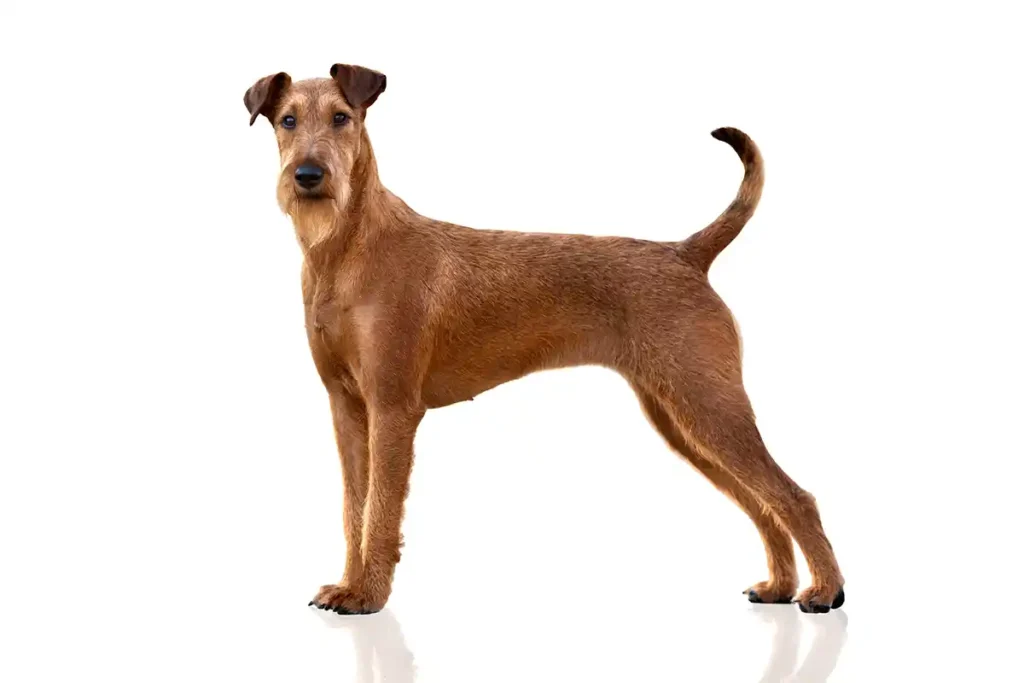
Physical Characteristics of the Irish Terrier
The Irish Terrier, with its bold red coat and athletic build, is a breed that exemplifies strength, agility, and elegance. Originally bred for guarding farms and hunting vermin, their physical traits reflect a perfect balance of resilience and beauty. These striking dogs are built to thrive in active environments, making them an excellent choice for families and individuals seeking a capable and spirited companion.
Size and Build
| Trait | Description |
|---|---|
| Average Height | Males: 18–20 inches (46–50 cm); females slightly smaller |
| Average Weight | 25–27 pounds (11–12 kg) |
| Body Type | Lean, muscular, and well-proportioned; ideal for endurance and agility |
Irish Terriers have a sleek, athletic frame that allows them to excel in physically demanding tasks. Their deep chest and straight, strong legs contribute to their speed and stamina, making them perfect companions for hiking, running, or farm work.
Notable Features
The Irish Terrier’s fiery appearance and alert posture set it apart as a breed of distinction. Their physical traits include:
- Eyes: Dark brown, medium-sized, and filled with intelligence and curiosity.
- Ears: Small, V-shaped, and neatly folded forward, giving them a keen, focused expression.
- Muzzle: Long, strong, and slightly tapering, suitable for carrying or holding objects.
- Tail: Moderately long and upright, showcasing their confidence and spirited nature.
Their movement is lively and graceful, a reflection of their agility and readiness—a hallmark of their working-dog roots.
Coat and Colors
| Trait | Description |
|---|---|
| Coat Type | Dense, wiry, and weather-resistant; provides excellent protection in outdoor conditions |
| Coat Texture | Coarse and harsh to the touch, with a softer insulating undercoat |
| Coloring | Shades of red, ranging from golden to deep, fiery hues |
The Irish Terrier’s signature coat is both functional and stunning. Its wiry texture offers protection against harsh weather and rough terrain, while the softer undercoat provides insulation. Regular hand-stripping maintains its natural texture and helps prevent matting.
Their iconic red coloring enhances their bold and confident appearance, making them instantly recognizable.
Facial Features and Posture
| Feature | Description |
|---|---|
| Eyes | Medium-sized, dark, and full of expression, reflecting intelligence and determination. |
| Ears | Neatly folded forward, enhancing their sharp, alert look. |
| Tail | Upright and moderately long, carried confidently to reflect their spirited character. |
The Irish Terrier’s balanced posture and confident demeanor convey a sense of readiness and alertness. Whether standing tall or in motion, they embody agility and purpose.
Key Physical Traits of the Irish Terrier
- Athletic Build: Lean and muscular, perfect for active lifestyles.
- Distinctive Coat: Weather-resistant and low-shedding, but requires regular grooming to maintain its health.
- Fiery Red Coloring: Their signature coat adds to their striking and bold appearance.
- Expressive Features: Keen eyes and an upright tail mirror their alert and lively nature.
Why Understanding These Characteristics Matters
Understanding the physical traits of the Irish Terrier is essential for providing proper care. Their athletic build and wiry coat require consistent exercise, grooming, and attention to detail, ensuring they remain healthy, comfortable, and ready for any adventure.
Why the Irish Terriers Stands Out
The Irish Terrier’s physical characteristics combine strength, elegance, and practicality. From their iconic red coat to their athletic build, they are as capable as they are striking. For owners seeking an active, confident, and low-shedding companion, the Irish Terrier offers unmatched versatility and charm.
Did you know that some Irish Terriers love sticking out their tongues? Find out other reasons why in this vet-reviewed guide.
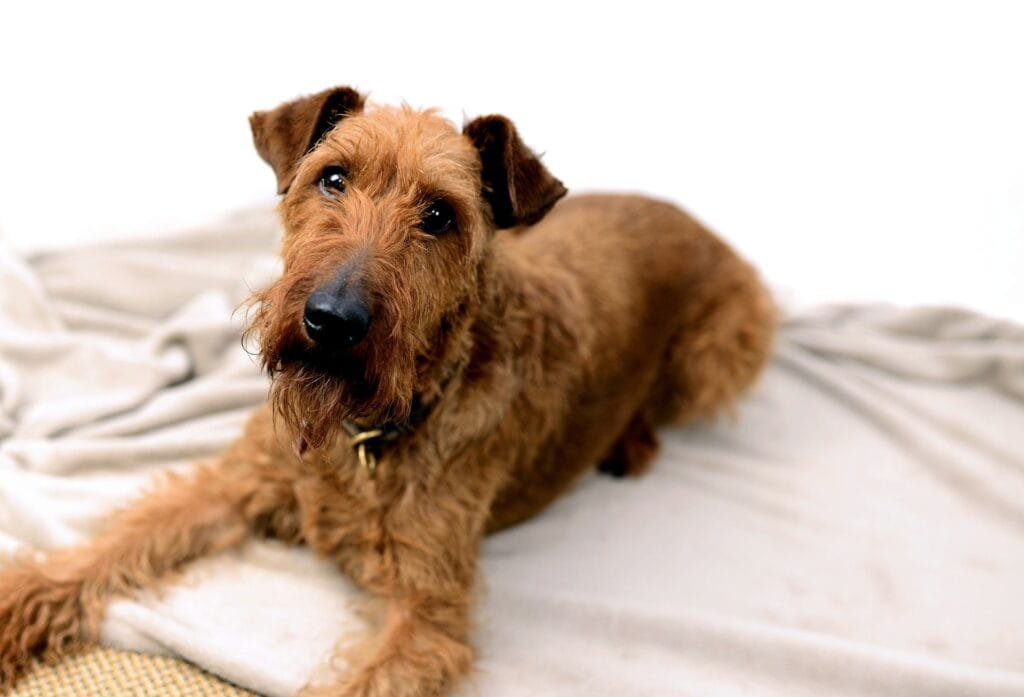
Health and Lifespan of the Irish Terrier
Irish Terriers are celebrated for their resilience, spirited nature, and affectionate companionship. While they are generally a hardy breed, proactive health management is essential to ensure they live long, happy lives. With an average lifespan of 13 to 15 years, Irish Terriers thrive when given proper nutrition, consistent exercise, and routine veterinary care.
Average Lifespan of Irish Terrier
The Irish Terrier’s average lifespan of 13 to 15 years is a testament to their robust genetics and active lifestyle. Factors like diet, exercise, and preventive care greatly influence their longevity, emphasizing the importance of early intervention and routine health monitoring.
Common Health Issues in Irish Terrier
Though generally healthy, Irish Terriers are predisposed to certain conditions. Awareness of these health concerns allows owners to take preventive steps and maintain their dog’s well-being.
| Condition | Description |
|---|---|
| Urinary Stones | Mineral buildup in the urinary tract, causing pain and possible blockages. |
| Hyperkeratosis | Thickening of the skin, especially on paw pads, leading to discomfort and cracking. |
| Allergies | Skin sensitivities causing itching, redness, or recurrent ear infections. |
| Hip Dysplasia | Improper hip joint development leading to arthritis and reduced mobility. |
| Eye Disorders | Conditions like cataracts or PRA, potentially causing vision impairment. |
| Obesity | Overfeeding and lack of exercise can result in weight-related complications. |
Preventive Care and Regular Vet Checkups
Preventive care is vital for maintaining your Irish Terrier’s health and vitality. From routine grooming to annual screenings, staying proactive ensures minor issues don’t escalate into serious problems.
| Health Aspect | Recommended Action | Frequency |
|---|---|---|
| Skin and Coat Health | Regular brushing and paw balm application to manage hyperkeratosis. | Weekly grooming; annual checks |
| Weight Management | Feed portion-controlled meals and engage in daily physical activity. | Monthly monitoring |
| Dental Care | Brush teeth and provide dental chews to maintain oral hygiene. | Weekly; professional cleanings annually |
| Eye Health | Regular screenings for cataracts or PRA. | Annually |
| Urinary Health | Ensure hydration and monitor urination patterns. | As needed; vet checks annually |
| Joint Health | Use joint supplements and monitor mobility in older dogs. | Annually or as needed |
Signs of Illness to Watch For in Irish Terrier
Being vigilant about changes in behavior or appearance can help identify potential health issues early. Monitor your Irish Terrier for the following symptoms:
- Mobility Issues: Limping, stiffness, or difficulty jumping may indicate joint pain or hip dysplasia.
- Excessive Scratching or Redness: Signs of skin allergies or hyperkeratosis.
- Weight Changes: Sudden weight loss or gain may signal metabolic issues or obesity.
- Cloudy Eyes or Vision Loss: Possible indicators of cataracts or PRA.
- Urination Issues: Straining, frequent urination, or blood in urine could suggest urinary stones.
Some owners explore options like “CBD oil for dogs” to manage joint discomfort.
Irish Terrier may face certain health challenges. Stay informed about the “11 Warning signs your dog needs a vet visit”.
Ensuring a Healthy Life for Your Irish Terrier
Proactive care ensures Irish Terriers live long, happy lives. Their energetic nature and love of companionship make regular exercise, mental stimulation, and routine healthcare essential for their overall well-being.
Key Areas of Care:
- Balanced Nutrition: Feed high-quality food tailored to their size, age, and activity level.
- Regular Exercise: Provide at least 1–2 hours of physical activity daily, including walks, runs, or agility games.
- Skin and Coat Care: Regular brushing and grooming prevent matting and address potential skin issues.
- Routine Veterinary Screenings: Annual exams, joint assessments, and eye checks ensure early detection of health concerns.
Why Health Awareness Matters
Understanding the health needs of Irish Terriers is crucial for ensuring their quality of life. By prioritizing preventive care, balanced nutrition, and regular exercise, you can enjoy many active, joyful years with your loyal and spirited companion.
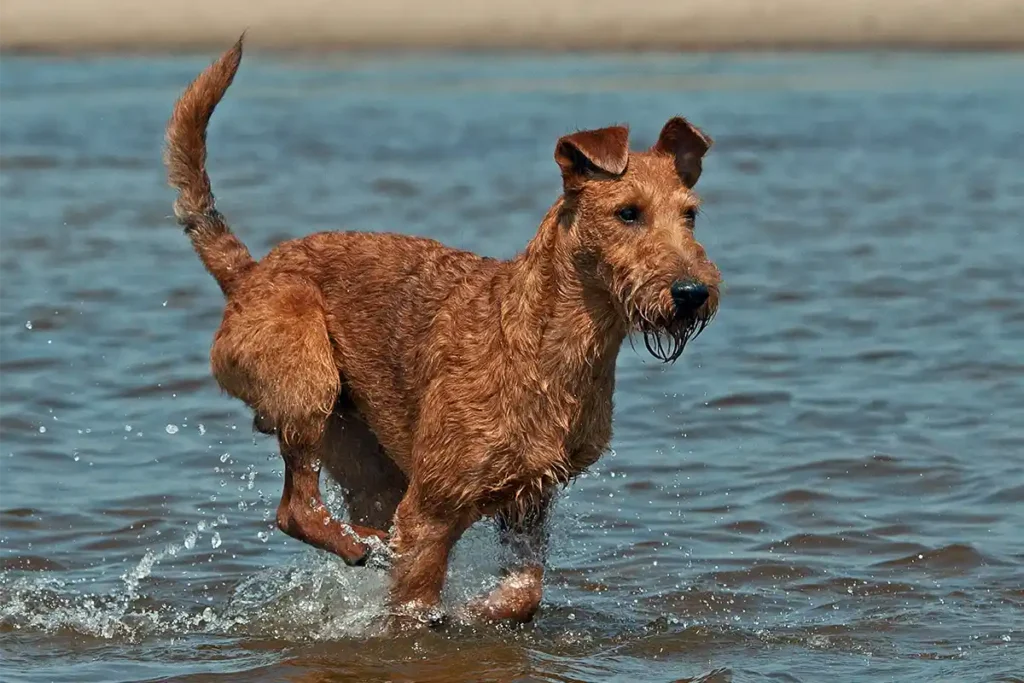
Caring for an Irish Terrier: Grooming, Diet and Enrichment Tips
Irish Terriers are energetic, intelligent, and affectionate companions who thrive when their care needs are met with consistency and attention. From maintaining their iconic wiry coat to providing stimulating activities, every aspect of their care contributes to a happy and well-adjusted pet. By addressing their grooming, diet, exercise, and mental enrichment, you can ensure your Irish Terrier lives a fulfilling and healthy life.
Table: Care Requirements for Irish Terrier
| Care Aspect | Requirement Level | Frequency | Details | Importance Rating |
|---|---|---|---|---|
| Grooming | High | Weekly | Brushing, hand-stripping, and nail trimming to maintain coat texture and skin health. | ⭐⭐⭐⭐⭐ |
| Feeding | High | Daily | High-quality, protein-rich diet with controlled portions to support energy and lean muscle mass. | ⭐⭐⭐⭐⭐ |
| Exercise | Very High | Daily | 1–2 hours of vigorous activity, including runs, walks, and play. | ⭐⭐⭐⭐⭐ |
| Mental Stimulation | Very High | Continuous | Training, interactive toys, and problem-solving games. | ⭐⭐⭐⭐⭐ |
| Environment | High | Continuous | Secure spaces for play, comfortable resting areas, and environmental enrichment. | ⭐⭐⭐⭐⭐ |
Grooming: Maintaining the Irish Terrier’s Distinct Coat
The Irish Terrier’s wiry coat is not only a hallmark of their breed but also a functional feature, providing protection against harsh weather. Proper grooming ensures their coat remains healthy, comfortable, and free from matting.
Key Grooming Practices:
- Brushing: Use a slicker or pin brush weekly to remove dirt, distribute natural oils, and keep their coat looking neat.
- Hand-Stripping: Schedule professional hand-stripping every 8–12 weeks to maintain the coat’s texture and health.
- Ear Care: Clean ears weekly with a vet-approved solution to reduce the risk of infections.
- Nail Trimming: Trim nails every 3–4 weeks to prevent overgrowth and discomfort.
- Dental Hygiene: Brush their teeth 2–3 times a week to maintain oral health and reduce plaque buildup.
Read more on “How to bathe your dog stress-free“
Diet and Nutrition: Fueling Their Energy and Vitality
Irish Terriers are high-energy dogs that require a balanced diet to support their active lifestyles. Proper nutrition ensures they maintain a healthy weight, shiny coat, and robust immune system.
Key Nutritional Needs:
- High-Quality Protein: Opt for premium dog food with real meat or fish as the first ingredient.
- Healthy Fats: Include Omega-3 and Omega-6 fatty acids to promote coat health and joint mobility.
- Controlled Portions: Avoid overfeeding to prevent obesity, which can strain joints and reduce overall health.
Feeding Schedule:
- Adults: Provide two well-portioned meals per day.
- Puppies: Feed 3–4 smaller meals daily to support their growth and development.
Hydration
Always provide fresh water, especially after exercise or during warm weather. Active dogs like Irish Terriers require consistent hydration to stay healthy.
Exercise: Channeling Their Boundless Energy
Irish Terriers are natural athletes, and regular exercise is crucial for their physical and mental well-being. Without proper outlets for their energy, they may develop destructive behaviors.
Physical Activity Recommendations:
- Daily Exercise: Provide 1–2 hours of physical activity, such as running, hiking, or agility training.
- Low-Impact Options: Swimming is an excellent activity for older dogs or those with joint concerns.
- Agility Training: Enroll them in courses to challenge their athleticism and keep them engaged.
Mental Stimulation:
- Puzzle Toys: Encourage problem-solving with interactive toys that reward curiosity.
- Training Sessions: Use positive reinforcement to teach commands and games.
- Scent Games: Mimic their natural hunting instincts with hide-and-seek or scent-tracking activities.
Interactive toys and training sessions are some of the “9 Simple ways to make your dogs happy”.
Creating a Comfortable Environment
Irish Terriers thrive in homes where they feel secure, stimulated, and included. Create a balanced environment that caters to their need for activity and rest.
Indoors:
- Provide a quiet resting area with soft bedding for relaxation after exercise.
- Use crates as safe spaces for downtime and travel.
Outdoors:
- Ensure a secure backyard for playtime, and offer enrichment like digging areas or obstacle courses.
- Provide shade and hydration during hot weather and warmth in colder months.
Why Proper Care Matters
Caring for an Irish Terrier requires dedication, but the rewards are endless. By focusing on grooming, nutrition, exercise, and enrichment, you’ll nurture a companion who is not only healthy but also brimming with joy and loyalty.

Owning an Irish Terrier: Budgeting and Financial Insights
Welcoming an Irish Terrier into your home is an exciting and fulfilling experience, but it comes with financial responsibilities. Planning ahead for both initial setup costs and ongoing care ensures your Irish Terrier thrives and lives a healthy, happy life. Here’s a detailed breakdown of the expenses associated with this spirited breed.
Table: Cost Breakdown Analysis for Irish Terrier
| Expense Category | Initial Cost (USD) | Annual Cost (USD) | Value Rating |
|---|---|---|---|
| Adoption or Breeder Fees | $300–$2,500 | N/A | ⭐⭐⭐⭐⭐ |
| Food and Treats | N/A | $500–$1,200 | ⭐⭐⭐⭐⭐ |
| Grooming | $50–$150 | $200–$500 | ⭐⭐⭐⭐ |
| Veterinary Care | $200–$600 | $500–$1,200 | ⭐⭐⭐⭐⭐ |
| Pet Insurance | N/A | $300–$900 | ⭐⭐⭐⭐ |
| Toys and Enrichment | $30–$100 | $100–$300 | ⭐⭐⭐⭐ |
| Training Classes | $100–$500 | Optional | ⭐⭐⭐⭐⭐ |
| Emergency Care | $200–$5,000+ (varies) | N/A | ⭐⭐⭐⭐ |
Initial Costs: Preparing for Your Irish Terrier
Adoption vs. Breeder Fees
- Adoption Fees ($300–$600): Adopting from a shelter or rescue is a cost-effective option that often includes vaccinations, microchipping, and spaying/neutering.
- Breeder Fees ($1,000–$2,500): Purchasing from a reputable breeder ensures health-tested puppies with lineage guarantees but comes at a premium.
Essential Supplies for Day One
Prepare your home with the following essentials to ensure a smooth transition for your Irish Terrier:
| Item | Cost Range (USD) |
|---|---|
| Dog Crate | $50–$150 |
| Food and Water Bowls | $20–$50 |
| Leash and Collar | $30–$60 |
| Bed | $40–$100 |
| Toys | $20–$50 |
| Grooming Supplies | $50–$100 |
| Training Tools | $20–$40 |
Estimated Setup Cost: $200–$500
🐾 Tailwaggors Tip:
Invest in durable supplies like chew-proof leashes, sturdy crates, and long-lasting toys. These may cost more upfront but save money over time.
Ongoing Annual Costs
Food and Treats
Irish Terriers require a nutritious diet to support their active lifestyles. Costs vary depending on the quality and type of food:
| Food Type | Annual Cost Range (USD) |
|---|---|
| Dry Food | $400–$800 |
| Wet Food (Optional) | $200–$400 |
| Specialty/High-Protein Diets | $800–$1,200 |
🐾 Tailwaggors Tip:
Mix dry kibble with wet food for variety and hydration. Consult your veterinarian to determine the best diet based on your Irish Terrier’s age, weight, and activity level.
Veterinary Care
Routine veterinary care ensures your Irish Terrier remains healthy and helps prevent costly emergencies:
| Category | Annual Cost Range (USD) |
|---|---|
| Wellness Exams | $150–$300 |
| Vaccinations | $50–$100 |
| Flea, Tick, and Worm Prevention | $100–$200 |
| Dental Cleaning | $300–$600 (every 1–2 years) |
🩺 Veterinary Insight:
“Irish Terriers are generally robust, but regular checkups and preventive care are vital to catch issues like joint pain or skin conditions early,” advises Dr. Esther Knoetze, BSc, BVSc.
Grooming
Irish Terriers’ dense, wiry coats require consistent care to maintain texture and prevent matting:
| Type | Annual Cost Range (USD) |
|---|---|
| Professional Grooming | $200–$500 |
| At-Home Grooming Supplies | $50–$100 |
🐾 Tailwaggors Tip:
Brush your Irish Terrier weekly and schedule hand-stripping every 8–12 weeks. Regular at-home grooming reduces professional grooming costs and keeps their coat in optimal condition.
Hidden and Emergency Costs
- Emergency Vet Visits: $200–$5,000+ for surgeries, diagnostics, or critical care.
- Pet Boarding or Sitting: $25–$50 per day during travel.
- Prescription Diets: $500–$1,200 annually for conditions like allergies or obesity management.
🐾 Tailwaggors Tip:
Consider pet insurance, which typically costs $300–$900 annually, to cover unexpected medical expenses. This provides peace of mind in emergencies.
Unexpected costs can arise. Prepare with this “Comprehensive Emergency guide for dog owners”.
Cost-Saving Strategies for Irish Terrier Owners
- Preventive Healthcare: Regular checkups catch potential issues early, reducing the need for costly treatments.
- DIY Grooming: Learn basic grooming skills like brushing and nail trimming to save on professional costs.
- Buy in Bulk: Purchase food and supplies in larger quantities to save money.
- Durable Supplies: Invest in high-quality toys, beds, and collars that withstand wear and tear.
Is Owning a Irish Terrier Worth the Investment?
Irish Terriers are loving, energetic companions that bring joy and adventure to their families. While their care requires financial planning, the investment is well worth the happiness and loyalty they offer. Budgeting for their needs—from food and veterinary care to grooming and enrichment—ensures they live a healthy, active, and fulfilling life.
🐾 Tailwaggors Tip:
Owning an Irish Terrier isn’t just a financial commitment—it’s an investment in a loyal and spirited companion. Plan ahead, embrace the journey, and your Irish Terrier will reward you with years of unconditional love and joy.
🩺 Veterinary Insight:
“Irish Terriers thrive when their care is tailored to their needs. Budgeting for regular exercise, preventive health care, and grooming ensures they lead long, happy lives,” says Dr. Esther Knoetze, BSc, BVSc.
Disclaimer:
The cost estimates provided in the “Owning an Alaskan Malamute: Budgeting and Financial Insights” section are general approximations based on current market trends and commonly reported expenses in the United States. Actual costs may vary depending on factors such as location, individual pet needs, specific health conditions, and lifestyle choices.
These estimates are intended for informational purposes only and should not replace personal research or consultations with veterinary or pet care professionals. We recommend setting aside additional funds for unexpected expenses, including emergency veterinary care and specialized dietary or training needs, to ensure your Alaskan Malamute receives the best possible care.
Always consult with a veterinarian or trusted breeder for detailed guidance tailored to your specific situation. Tailwaggors is not responsible for discrepancies or unforeseen costs that may arise.
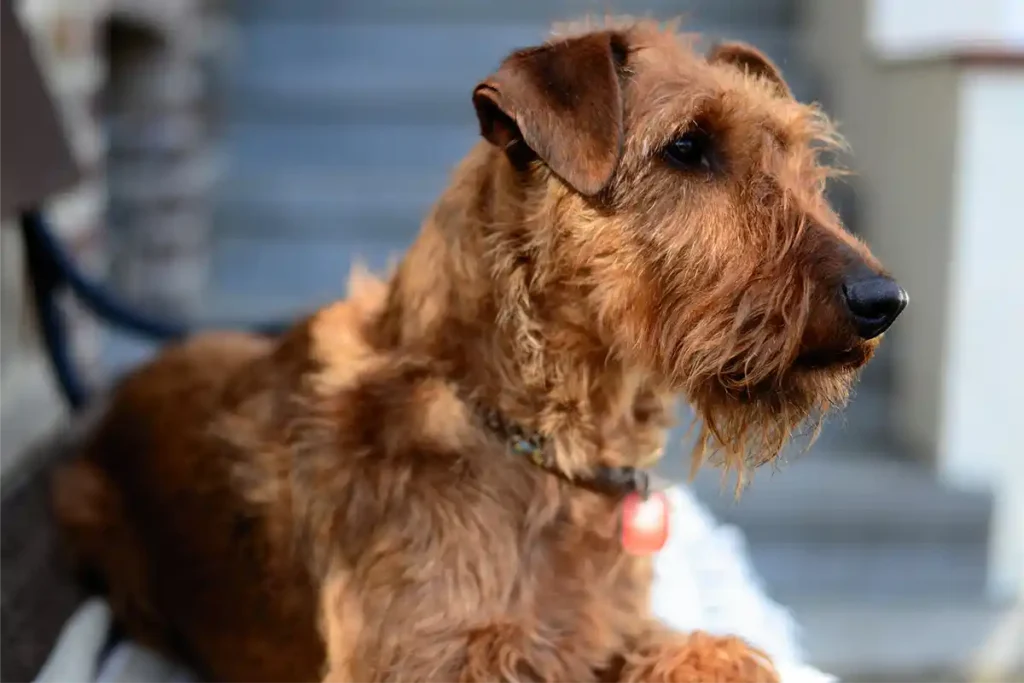
Breed Comparison: Irish Terrier vs. Other Popular Breeds
Choosing the right dog breed involves evaluating factors like size, temperament, energy levels, and grooming needs. The Irish Terrier, known for its bold personality and distinctive coat, is often compared to other terriers, including the Airedale Terrier, Border Terrier, and Fox Terrier. Here’s how the Irish Terrier stacks up against these breeds to help you determine which fits your lifestyle best.
Table: How Does the Irish Terrier Compare?
| Aspect | Irish Terrier | Airedale Terrier | Border Terrier | Fox Terrier |
|---|---|---|---|---|
| Size | Medium (25–27 lbs / 11–12 kg) | Large (50–70 lbs / 23–32 kg) | Small (11–16 lbs / 5–7 kg) | Small (15–18 lbs / 7–8 kg) |
| Coat | Dense, wiry, weather-resistant | Dense, wiry, weather-resistant | Coarse, dense double coat | Smooth or wire, requires regular grooming |
| Personality | Spirited, loyal, fearless | Confident, friendly, intelligent | Friendly, adaptable, affectionate | Playful, lively, bold |
| Grooming Needs | Moderate (regular brushing, hand-stripping) | Moderate (regular brushing, hand-stripping) | Low (occasional brushing) | High (regular brushing, occasional trimming) |
| Energy Level | High; thrives on activity | High; needs structured physical and mental activities | Moderate; adaptable to exercise needs | High; active and energetic |
| Trainability | Intelligent but independent | Highly trainable with consistent guidance | Very trainable, eager to please | Highly trainable, enjoys challenges |
| Compatibility with Pets | Good; benefits from early socialization | Good; requires early training to prevent dominance | Excellent; highly sociable | Good; may display prey drive |
Irish Terrier vs. Airedale Terrier
The Irish Terrier and Airedale Terrier share similar temperaments and grooming needs but differ in size and energy levels.
- Size and Space Needs: Airedale Terriers are significantly larger, making them better suited for spacious homes, while Irish Terriers adapt well to smaller living environments with sufficient exercise.
- Temperament: Both breeds are confident and spirited, but Irish Terriers are more independent and may be reserved with strangers.
- Grooming: Both require regular hand-stripping, but the larger Airedale’s coat demands more maintenance overall.
🐾 Tailwaggors Tip:
For a bold, compact companion with high energy, choose the Irish Terrier. For families with space and time for training, the Airedale’s size and friendly demeanor might be a better match.
Irish Terrier vs. Border Terrier
Both breeds are friendly and energetic, but the Irish Terrier offers a more spirited and independent personality.
- Size: Border Terriers are smaller and may suit apartment living better.
- Energy Levels: Irish Terriers require more structured exercise, while Border Terriers are adaptable to varying activity levels.
- Grooming: Border Terriers are lower maintenance, while Irish Terriers benefit from regular hand-stripping.
🐾 Tailwaggors Tip:
Choose the Irish Terrier if you’re seeking an adventurous and bold companion. Opt for the Border Terrier if you prefer a smaller, more adaptable breed with less grooming needs.
Irish Terrier vs. Fox Terrier
BoThe Irish Terrier and Fox Terrier are lively, intelligent breeds with distinct physical and behavioral differences.
- Coat: Fox Terriers have smooth or wire coats requiring less frequent hand-stripping but regular brushing.
- Temperament: Fox Terriers are more playful and outgoing, while Irish Terriers balance independence with loyalty.
- Energy Levels: Both breeds are active, but Fox Terriers thrive on mental stimulation and interactive play.
🐾 Tailwaggors Tip:
For a courageous, independent breed with moderate grooming needs, the Irish Terrier is ideal. If you prefer a smaller, playful dog with lower grooming demands, the Fox Terrier is a great alternative.
Why Choose the Irish Terrier?
The Irish Terrier stands out for its bold nature, loyalty, and high energy, making it a perfect fit for active families or individuals who enjoy outdoor adventures. With moderate grooming needs and a fearless personality, this breed thrives in environments where they can be both companions and protectors.
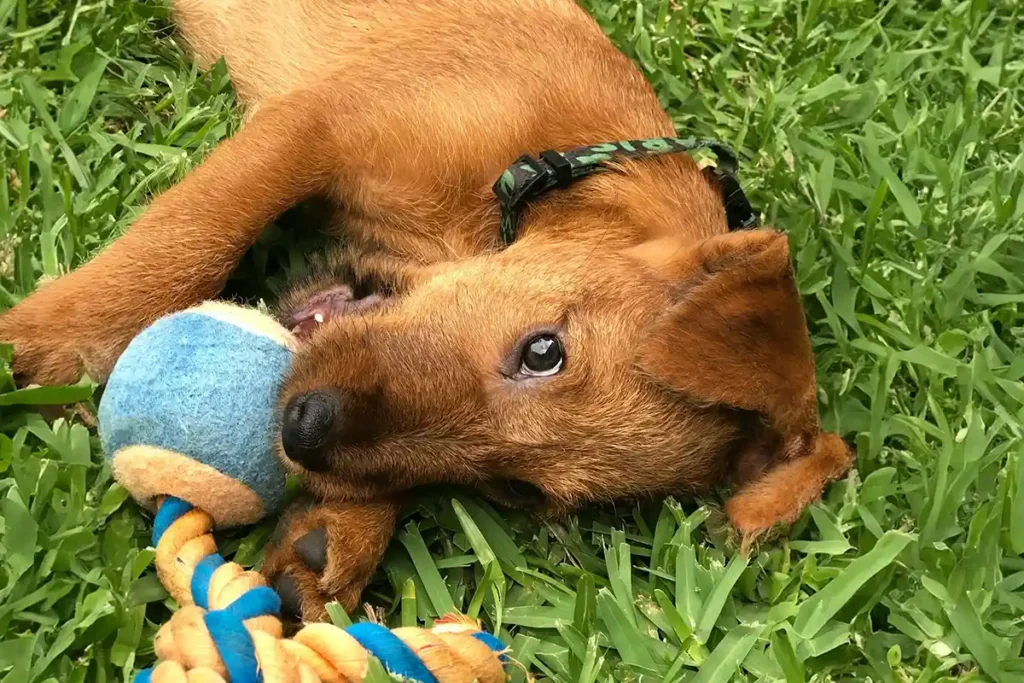
Frequently Asked Questions About the Irish Terrier
Irish Terriers are spirited, intelligent, and loving companions that bring energy and devotion to any household. Whether you’re considering adding an Irish Terrier to your family or are already a proud owner, these FAQs address the most common questions about this bold and fearless breed.
1. Are Irish Terriers hypoallergenic?
+Yes, Irish Terriers are considered hypoallergenic due to their wiry coats, which shed minimally. However, they still produce dander, so allergy sufferers should spend time with the breed to assess compatibility.
🐾 Tailwaggors Tip:
Brush your Irish Terrier weekly and schedule hand-stripping every 8–12 weeks to further reduce allergens and maintain their coat health.
2. How much do Irish Terriers weigh?
+Irish Terriers typically weigh 25–27 pounds (11–12 kg), making them a medium-sized breed with a lean, muscular frame suited for active families or individuals.
3. How long do Irish Terriers live?
+The average lifespan of an Irish Terrier is 13–15 years. Providing a balanced diet, regular exercise, and preventive veterinary care ensures they live a long and healthy life.
🩺 Veterinary Insight:
“Irish Terriers are generally healthy but can benefit from joint supplements and regular checkups as they age. Early intervention can prevent common issues like arthritis,” advises Dr. Esther Knoetze, BSc, BVSc.
4. Are Irish Terriers good with children?
+Yes, Irish Terriers are excellent with children. Their playful energy and protective nature make them great companions for families.
🐾 Tailwaggors Tip:
Supervise interactions between young children and Irish Terriers to ensure safe and enjoyable playtime for both.
5. Do Irish Terriers bark a lot?
+Irish Terriers are moderate barkers. They typically bark to alert their families of strangers or unusual events but aren’t overly vocal.
6. How much exercise do Irish Terriers need?
+Irish Terriers require 1–2 hours of daily exercise to channel their energy. Activities like jogging, hiking, or agility training are ideal.
🐾 Tailwaggors Tip:
Incorporate mental stimulation, like puzzle toys or scent games, alongside physical activities to keep your Irish Terrier well-rounded and happy.
7. Are Irish Terriers easy to train?
+Irish Terriers are intelligent but can be independent thinkers. Early socialization and consistent, positive reinforcement are key to successful training.
🐾 Tailwaggors Tip:
Keep training sessions short, fun, and engaging. Use treats, praise, and toys to keep their attention and motivation high.
8. What are the grooming needs of an Irish Terrier?
+Irish Terriers’ wiry coats require moderate grooming:
- Weekly brushing to remove debris and maintain texture
- Hand-stripping every 8–12 weeks for coat health and appearance
- Regular ear cleaning to prevent infections
🩺 Veterinary Insight:
“Routine grooming allows owners to spot early signs of skin irritation or lumps, ensuring issues are addressed promptly,” notes Dr. Knoetze.
9. Are Irish Terriers prone to health issues?
+While generally healthy, Irish Terriers may develop:
- Skin Conditions: Hyperkeratosis or allergies causing irritation
- Joint Issues: Arthritis or stiffness in older dogs
Preventive care, including balanced nutrition and routine vet visits, helps manage these concerns.
10. Can Irish Terriers live in apartments?
+Yes, Irish Terriers can adapt to apartment living if their exercise needs are met. Without adequate activity, they may develop destructive behaviors.
🐾 Tailwaggors Tip:
Engage your Irish Terrier with daily walks, interactive toys, and training games to keep them entertained and content in smaller spaces.
Why These FAQs Matter
Understanding the Irish Terrier’s unique traits and care needs ensures they thrive in your home. From exercise and grooming to training and health care, these FAQs provide the knowledge needed to give your Irish Terrier a happy, healthy life.
Are Irish Terriers safe around plants? Learn which plants to avoid with this vet-approved guide on toxic plants for dogs. Be prepared for emergencies by learning first aid for pets.
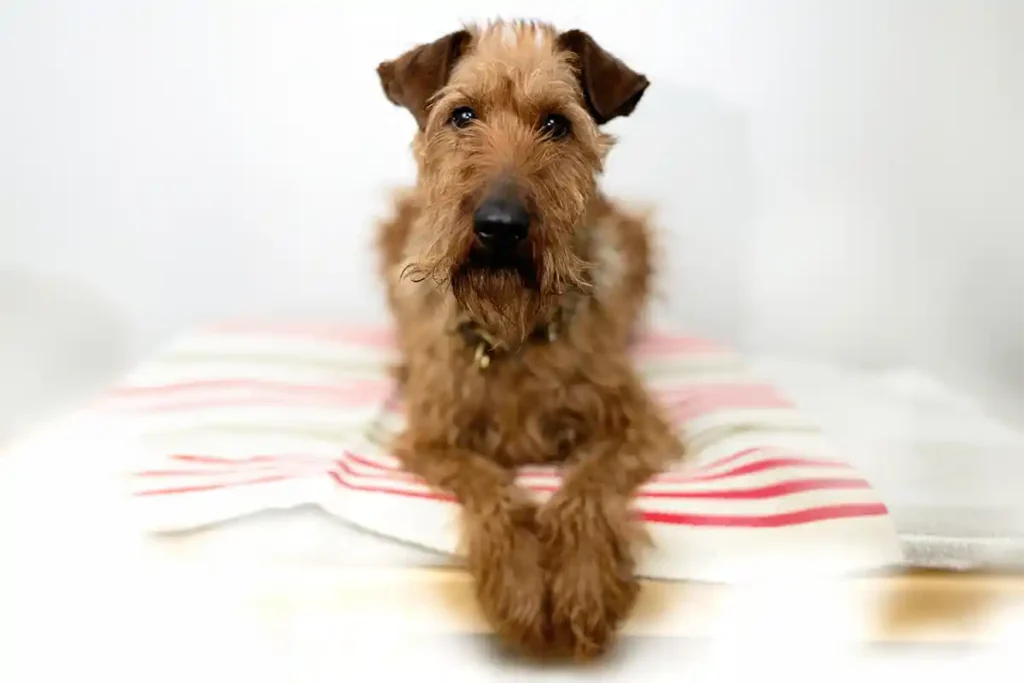
Conclusion: Wrapping Up the Ultimate Guide to the Irish Terrier
The Irish Terrier embodies the qualities of a truly remarkable companion: boldness, loyalty, and an adventurous spirit. Whether as a devoted family member, a vigilant watchdog, or a spirited outdoor partner, the Irish Terrier thrives in roles that challenge their intelligence and energy. Their distinctive personality and courage have earned them a place in the hearts of dog lovers worldwide.
Providing the Best Care for Your Irish Terrier
To ensure your Irish Terrier enjoys a long, healthy, and happy life, focus on these essential care practices:
- Grooming: Brush weekly, schedule professional hand-stripping every 8–12 weeks, and monitor for signs of skin irritation or dryness.
- Nutrition: Offer a protein-rich, balanced diet tailored to their size, age, and activity level.
- Exercise and Enrichment: Engage in 1–2 hours of daily activity, combining physical exercise with mental stimulation like scent games or problem-solving tasks.
- Veterinary Care: Schedule regular health checkups and screenings for breed-specific concerns like skin conditions and joint health.
Is the Irish Terrier Right for You?
Adopting an Irish Terrier is a rewarding journey for those prepared to meet their needs. These energetic and intelligent dogs are best suited for:
- Active Individuals or Families: Irish Terriers thrive in homes where outdoor activities like running, hiking, or agility training are part of the routine.
- Committed Owners: Consistent grooming, training, and exercise routines are essential to keep them happy and well-behaved.
- Loving Homes: With their loyalty and protective nature, Irish Terriers bond deeply with their families and thrive on companionship.
If you’re ready to welcome an Irish Terrier into your life, you’ll gain a devoted family member who brings joy, adventure, and love into every day. Read more on 10 things to concider before bringing a new pet home.

Share Your Irish Terrier Story!
Have you experienced the joy of living with an Irish Terrier? Share your favorite moments, care tips, and insights in the comments section below. Connect with us on social media for expert advice, heartwarming stories, and updates on Irish Terriers and other incredible breeds. Contact Tailwaggors.
🐾✨ Discover the Bold Spirit of the Irish Terrier!
Explore their fearless personality, care essentials, and why they’re celebrated as the “Daredevil of the Dog World.”
Share with fellow dog lovers and celebrate this exceptional breed! 🐶❤️


